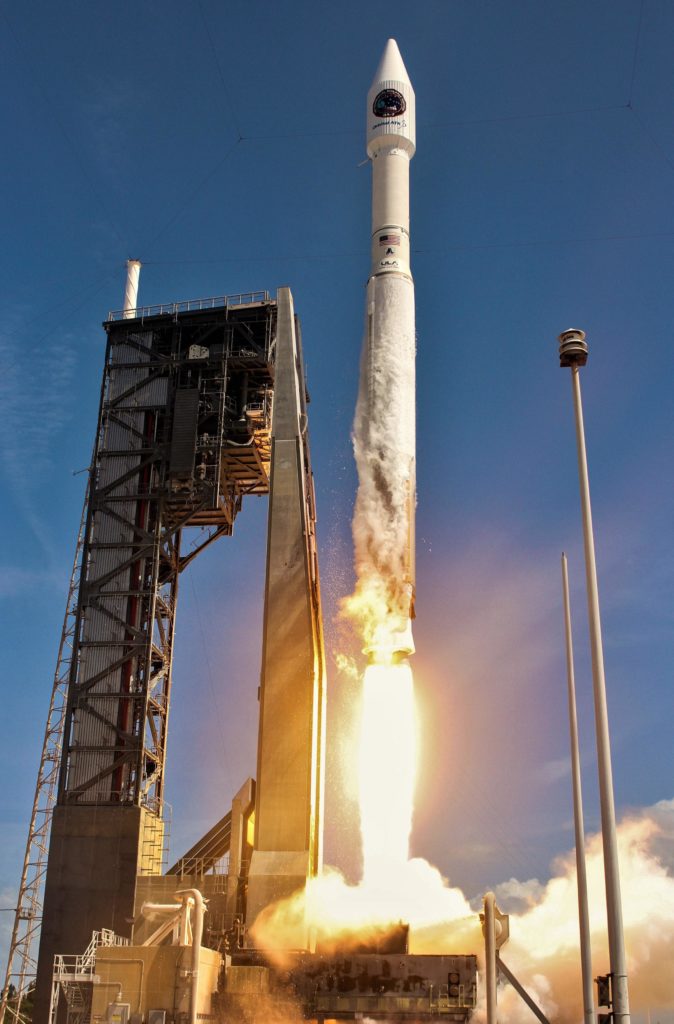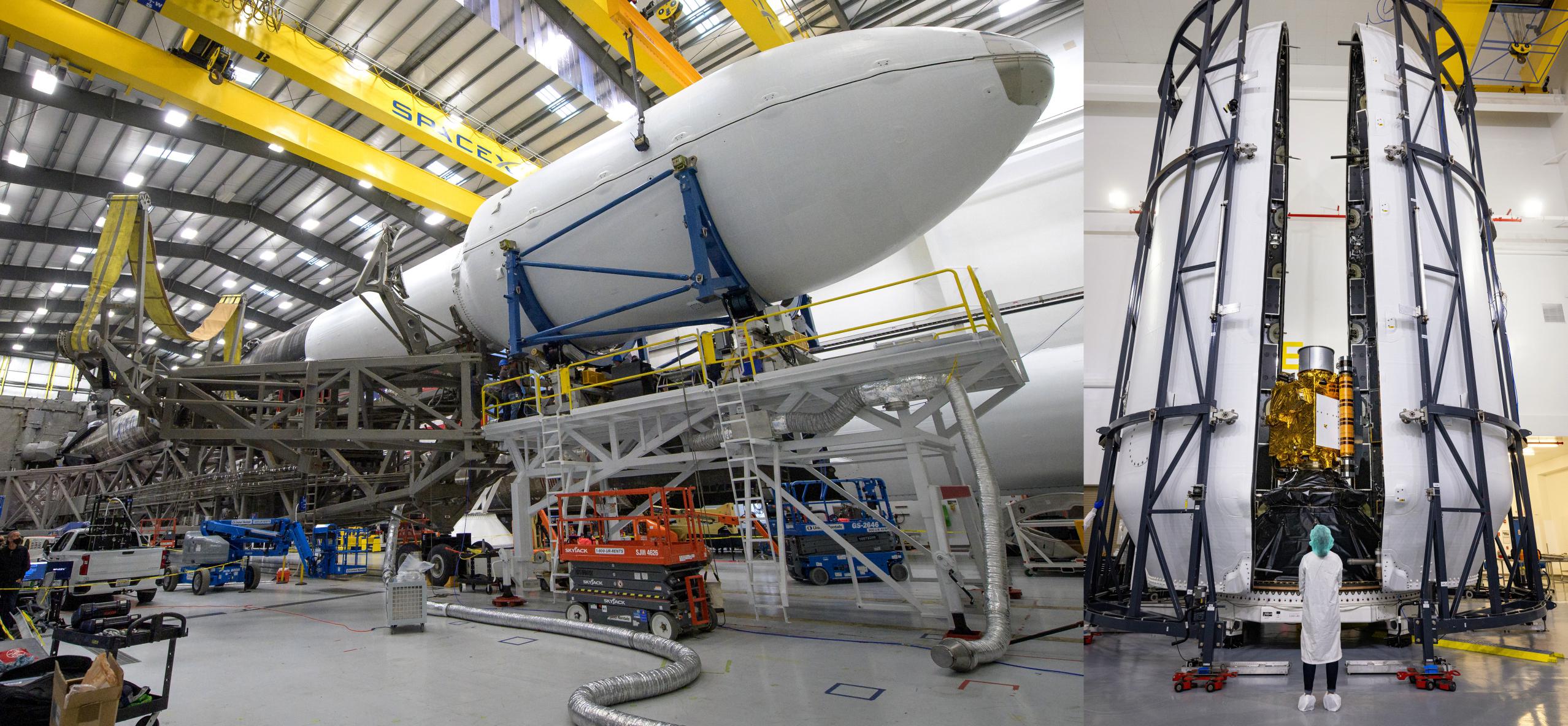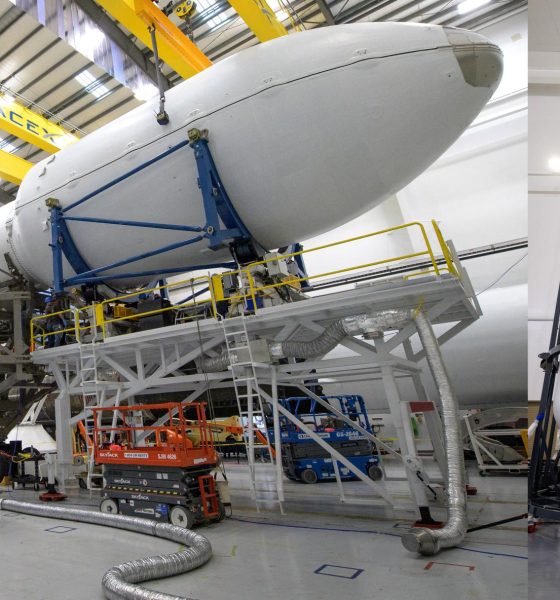NASA says SpaceX has finished encapsulating its DART asteroid redirection spacecraft inside Falcon 9’s fairing and opened up its West Coast launch pad hangar to give VIPs and mission team members a tour of their rocket.
Measuring 70m (230ft) tall, 550 metric tons (1.2M lb) fully fueled, and capable of producing more than 775 tons (1.71M lbf) of thrust at liftoff, Falcon 9 remains on track to launch NASA’s Double Asteroid Redirection Test mission no earlier than 10:21 pm PST, Wednesday, November 23rd (06:21 UTC 24 Nov). While there are multiple conflicting reports of the spacecraft’s launch mass, it will likely weigh between 600 and 650 kg (1300-1450 lb) – a minuscule 0.1% of the rocket’s total mass at liftoff. In simpler terms, Falcon 9 launching DART is a bit like a semi-truck carrying a single piece of wood.
Nevertheless, just like that semi-truck scenario, it might not be the most efficient choice of vehicle but sometimes a one-size-fits-all rocket like Falcon 9 can make a lot of sense.
Notably, despite being outsized by at least a factor of 2-3, Falcon 9’s DART launch will ultimately cost NASA about $73M – about a quarter of the mission’s total ~$250M cost. Nominally headed to interplanetary space, there isn’t a smallsat launcher (i.e. Firefly Alpha, Relativity Terran-1, Virgin Orbit LauncherOne, ABL Space RS-1, etc.) currently in development that’s expected to be able to launch a ~600 kg payload onto the interplanetary trajectory Falcon 9 will send DART on. If there were, it might theoretically cost NASA just ~$20M to launch DART but it will also take years for any of the new small to midsize rockets that might have enough performance to establish a track record of reliability, meaning that NASA would have to accept significant risk for that potential discount.

It’s worth noting that based on several comments from executives indicating that a flight-proven Falcon 9 costs about $15-25M to launch, SpaceX could almost certainly charge NASA half as much to launch DART while still breaking even, with its routine reusability making the potential economic advantage of smaller rockets much murkier. Additionally, despite the potential to save another $30-50M, NASA is still likely saving at least $80-100 million by launching on a $73M Falcon 9 rocket rather than the United Launch Alliance’s (ULA) cheapest Atlas V offering, which NASA has paid around $150-175M for in recent years.
While SpaceX has technically launched two similarly tiny NASA payloads to very high orbits ~300,000 and ~900,000 km (150,000-600,000 mi) away from Earth in 2015 and 2018, as well as CEO Elon Musk’s Tesla Roadster on an Earth escape trajectory with Falcon Heavy, data from JPL recently confirmed that DART will be Falcon 9’s first truly interplanetary launch. After reaching a normal low Earth parking orbit, Falcon 9’s expendable upper stage will ultimately boost the small spacecraft free of Earth’s gravity, sending it into a heliocentric orbit that will eventually intersect with the binary Didymos-Dimorphos asteroid system.
As early as September 2022, DART will slam into asteroid moon Dimorphos while traveling a staggering 6.6 kilometers per second (4.1 mi/s) in an attempt to shift its orbit around the larger Didymos asteroid. In effect, NASA is using the asteroid system a bit like an isolated sandbox to (hopefully) exaggerate any effects. If successful, DART will prove that kinetic impactors offer a viable way to change the course of asteroids and comets, potentially paving the way for the creation of a true planetary defense program.

Elon Musk
GM CEO Mary Barra says she told Biden to give Tesla and Musk EV credit
“He was crediting me, and I said, ‘Actually, I think a lot of that credit goes to Elon and Tesla…You know me, Andrew. I don’t want to take credit for things.”

General Motors CEO Mary Barra said in a new interview on Wednesday that she told President Joe Biden to credit Tesla and its CEO, Elon Musk, for the widespread electric vehicle transition.
She said she told Biden this after the former President credited her and GM for leading EV efforts in the United States.
During an interview at the New York Times Dealbook Summit with Andrew Ross Sorkin, Barra said she told Biden that crediting her was essentially a mistake, and that Musk and Tesla should have been explicitly mentioned (via Business Insider):
“He was crediting me, and I said, ‘Actually, I think a lot of that credit goes to Elon and Tesla…You know me, Andrew. I don’t want to take credit for things.”
GM CEO Mary Barra said to Andrew Sorkin at the New York Times Dealbook Summit that she pulled President Biden aside and said Tesla CEO @elonmusk deserved the credit for EVs:
“He was crediting me, and I said, ‘Actually, I think a lot of that credit goes to Elon and Tesla,'” Barra… pic.twitter.com/OHBTG1QfbJ
— TESLARATI (@Teslarati) December 3, 2025
Back in 2021, President Biden visited GM’s “Factory Zero” plant in Detroit, which was the centerpiece of the company’s massive transition to EVs. The former President went on to discuss the EV industry, and claimed that GM and Barra were the true leaders who caused the change:
“In the auto industry, Detroit is leading the world in electric vehicles. You know how critical it is? Mary, I remember talking to you way back in January about the need for America to lead in electric vehicles. I can remember your dramatic announcement that by 2035, GM would be 100% electric. You changed the whole story, Mary. You did, Mary. You electrified the entire automotive industry. I’m serious. You led, and it matters.”
People were baffled by the President’s decision to highlight GM and Barra, and not Tesla and Musk, who truly started the transition to EVs. GM, Ford, and many other companies only followed in the footsteps of Tesla after it started to take market share from them.
Elon Musk and Tesla try to save legacy automakers from Déjà vu
Musk would eventually go on to talk about Biden’s words later on:
“They have so much power over the White House that they can exclude Tesla from an EV Summit. And, in case the first thing, in case that wasn’t enough, then you have President Biden with Mary Barra at a subsequent event, congratulating Mary for having led the EV revolution.”
In Q4 2021, which was shortly after Biden’s comments, Tesla delivered 300,000 EVs. GM delivered just 26.
News
Tesla Full Self-Driving shows confident navigation in heavy snow
So far, from what we’ve seen, snow has not been a huge issue for the most recent Full Self-Driving release. It seems to be acting confidently and handling even snow-covered roads with relative ease.

Tesla Full Self-Driving is getting its first taste of Winter weather for late 2025, as snow is starting to fall all across the United States.
The suite has been vastly improved after Tesla released v14 to many owners with capable hardware, and driving performance, along with overall behavior, has really been something to admire. This is by far the best version of FSD Tesla has ever released, and although there are a handful of regressions with each subsequent release, they are usually cleared up within a week or two.
Tesla is releasing a modified version of FSD v14 for Hardware 3 owners: here’s when
However, adverse weather conditions are something that Tesla will have to confront, as heavy rain, snow, and other interesting situations are bound to occur. In order for the vehicles to be fully autonomous, they will have to go through these scenarios safely and accurately.
One big issue I’ve had, especially in heavy rain, is that the camera vision might be obstructed, which will display messages that certain features’ performance might be degraded.
So far, from what we’ve seen, snow has not been a huge issue for the most recent Full Self-Driving release. It seems to be acting confidently and handling even snow-covered roads with relative ease:
FSD 14.1.4 snow storm Ontario Canada pic.twitter.com/jwK1dLYT0w
— Everything AI (@mrteslaspace) November 17, 2025
I found the steepest, unplowed hill in my area and tested the following:
• FSD 14.2.1 on summer tires
• FSD 14.2.1 on winter tires
• Manual drivingBut I think the most impressive part was how FSD went DOWN the hill. FSD in the snow is sublime $TSLA pic.twitter.com/YMcN7Br3PU
— Dillon Loomis (@DillonLoomis) December 2, 2025
Well.. I couldn’t let the boys have all the fun!
Threw the GoPro up and decided to FSD v14.2.1 in the snow. Roads were not compacted like the other day, a little slippery, but overall doable at lower speeds. Enjoy the video and holiday music 🎶
Liked:
Took turns super slow… pic.twitter.com/rIAIeh3Zu3— 🦋Diana🦋 (@99_Colorado) December 3, 2025
Moving into the winter months, it will be very interesting to see how FSD handles even more concerning conditions, especially with black ice, freezing rain and snow mix, and other things that happen during colder conditions.
We are excited to test it ourselves, but I am waiting for heavy snowfall to make it to Pennsylvania so I can truly push it to the limit.
News
Tesla hosts Rome Mayor for first Italian FSD Supervised road demo
The event marked the first time an Italian mayor tested the advanced driver-assistance system in person in Rome’s urban streets.

Tesla definitely seems to be actively engaging European officials on FSD’s capabilities, with the company hosting Rome Mayor Roberto Gualtieri and Mobility Assessor Eugenio Patanè for a hands-on road demonstration.
The event marked the first time an Italian mayor tested the advanced driver-assistance system in person in Rome’s urban streets. This comes amid Tesla’s push for FSD’s EU regulatory approvals in the coming year.
Rome officials experience FSD Supervised
Tesla conducted the demo using a Model 3 equipped with Full Self-Driving (Supervised), tackling typical Roman traffic including complex intersections, roundabouts, pedestrian crossings and mixed users like cars, bikes and scooters.
The system showcased AI-based assisted driving, prioritizing safety while maintaining flow. FSD also handled overtakes and lane decisions, though with constant driver supervision.
Investor Andrea Stroppa detailed the event on X, noting the system’s potential to reduce severe collision risks by up to seven times compared to traditional driving, based on Tesla’s data from billions of global fleet miles. The session highlighted FSD’s role as an assistance tool in its Supervised form, not a replacement, with the driver fully responsible at all times.
Path to European rollout
Tesla has logged over 1 million kilometers of testing across 17 European countries, including Italy, to refine FSD for local conditions. The fact that Rome officials personally tested FSD Supervised bodes well for the program’s approval, as it suggests that key individuals are closely watching Tesla’s efforts and innovations.
Assessor Patanè also highlighted the administration’s interest in technologies that boost road safety and urban travel quality, viewing them as aids for both private and public transport while respecting rules.
Replies on X urged involving Italy’s Transport Ministry to speed approvals, with one user noting, “Great idea to involve the mayor! It would be necessary to involve components of the Ministry of Transport and the government as soon as possible: it’s they who can accelerate the approval of FSD in Italy.”










